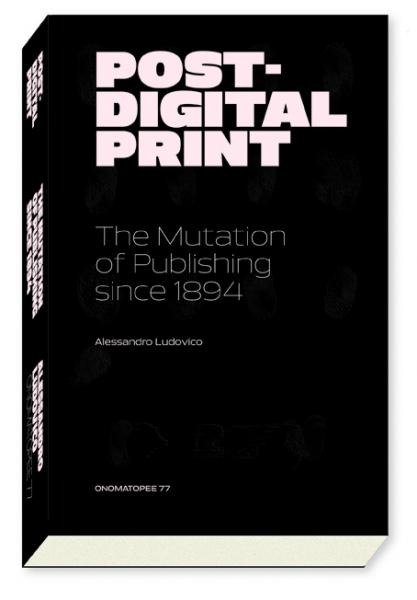Alessandro Ludovico: Post-Digital Print: The Mutation of Publishing Since 1894 (2012–) [EN, IT]
Filed under book | Tags: · archive, book, e-book, filesharing, library, networks, print, publishing, reading, text, writing

“In the post-digital age, digital technology is no longer revolutionary but a normality, everywhere. For music or film, circulation as bits and bytes, downloads and streams are no longer a big deal. But for the world of book and magazine publishing, change has just begun.
New ways of networked and electronic publishing had been envisioned by avant-garde artists, activists and technologists for more than a century. Even though in hindsight the reports of the death of paper were greatly exaggerated, electronic publishing has now become a reality. How will analog and digital coexist in the post-digital age of publishing? How will they transition, mix and cross over?
In this book, Alessandro Ludovico rereads the history of avant-garde arts as a prehistory of cutting through the opposites of paper and electronics. He covers, among others, artists’ books and manifests, zines, net art and experimental publishing projects, up to e-readers and print-on-demand.”
With Afterword by Florian Cramer
Publisher Creating 010, Hogeschool Rotterdam & Onomatopee, Eindhoven, May 2012
Onomatopee 77: Cabinet Project
Creative Commons Attribution-NonCommercial-ShareAlike 3.0 Unported License
ISBN 9789078454878, 9078454873
192 pages
via Florian Cramer
Interview with author: Teresa de Andrés (VisualMag, 2012).
Reviews: Franz Thalmair (Springerin, 2012), Regine Debatty (We Make Money Not Art, 2013), Rob Myers (Furtherfield, 2013), Paul Prudence (Neural, 2013), brnrd.net (2013), Kate Cunningham (Yapp, 2014), Eloïse Cariou (Critique d’art, 2016, FR), Benjamin Caraco (BBF, 2017, FR).
Book launch (Eindhoven, 2012)
Post Digital Print (series of activities around the publication, 2012)
Book website
Publisher (EN)
Publisher (IT, archived)
WorldCat (EN)
Wikipedia
Post-Digital Print (English, 2012, updated on 2012-5-31 to the latest version of the book, Internet Archive)
Post-digital print. La mutazione dell’editoria dal 1894 (Italian, trans. Alessandro Ludovico and Rosa Antonicelli Verrelli, 2014, added on 2020-6-3)
Vilém Flusser: Does Writing Have a Future? (1987/2011)
Filed under book | Tags: · artificial intelligence, language, philosophy, print, reading, text, textuality, writing
“In Does Writing Have a Future?, a remarkably perceptive work first published in German in 1987, Vilém Flusser asks what will happen to thought and communication as written communication gives way, inevitably, to digital expression. In his introduction, Flusser proposes that writing does not, in fact, have a future because everything that is now conveyed in writing—and much that cannot be—can be recorded and transmitted by other means.
Confirming Flusser’s status as a theorist of new media in the same rank as Marshall McLuhan, Jean Baudrillard, Paul Virilio, and Friedrich Kittler, the balance of this book teases out the nuances of these developments. To find a common denominator among texts and practices that span millennia, Flusser looks back to the earliest forms of writing and forward to the digitization of texts now under way. For Flusser, writing—despite its limitations when compared to digital media—underpins historical consciousness, the concept of progress, and the nature of critical inquiry. While the text as a cultural form may ultimately become superfluous, he argues, the art of writing will not so much disappear but rather evolve into new kinds of thought and expression.”
Originally published in German in 1987 as Die Schrift. Hat Schreiben Zukunft?, Göttingen.
Translated by Nancy Ann Roth
Introduction by Mark Poster
Publisher University of Minnesota Press, 2011
Volume 33 of Electronic Mediations
ISBN 0816670234, 9780816670239
208 pages
Review: Bob Hanke (Int’l J of Communication)
PDF (updated on 2020-2-29)
Comments (6)I Read Where I Am: Exploring New Information Cultures (2011)
Filed under book | Tags: · book, hypertext, internet, reading, text, textuality

“”I Read Where I Am” contains visionary texts about the future of reading and the status of the word. We read at any time and anywhere. We read from screens, we read out on the streets, we read in the office but we spend less and less time reading a book at home on the couch. We are, or are becoming, a different type of reader. Reading is becoming a different experience. Different from what it once was.
We have access to almost all information at any given time. We carry complete libraries in our pockets. Books have become part of the multi-media world, the can be shared between platforms.
Do all these extra possibilities add value or are they a mere distraction? We read the text as much as we read the interface. With similar ease, we read newspaper articles as well as search engines, databases, and navigational structures. Texts and images become interchangeable, creating new forms of information. Differences in content and between readers require different shapes and experiences. The question remains: which shape will it take and what experience does one want?
To answer to all these (and other) questions, we have asked people from different backgrounds, to think about these issues in the light of these changes. “I Read Where I Am” is a varied collection of 82 observations, inspirations, and critical notes by journalists, designers, researchers, politicians, philosophers, and many others.” (from book launch announcement)
Concept: Graphic Design Museum/Institute of Network Cultures
Editors: Mieke Gerritzen, Geert Lovink, Minke Kampman
Editorial assistance: Morgan Currie
Translation Dutch-English: Jonathan Ellis
Design: LUST
Production: Valiz
Publisher: Valiz with Graphic Design Museum, May 2011
ISBN 978-90-78088-55-4
authors
via The Unbound Book conference
PDF (EPUB; added on 2012-7-17)
View online (HTML)

